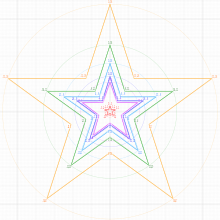Integer lattice


In mathematics, the n-dimensional integer lattice (or cubic lattice), denoted , is the lattice in the Euclidean space whose lattice points are n-tuples of integers. The two-dimensional integer lattice is also called the square lattice, or grid lattice. is the simplest example of a root lattice. The integer lattice is an odd unimodular lattice.
Automorphism group
The automorphism group (or group of congruences) of the integer lattice consists of all permutations and sign changes of the coordinates, and is of order 2n n!. As a matrix group it is given by the set of all n×n signed permutation matrices. This group is isomorphic to the semidirect product
where the symmetric group Sn acts on (Z2)n by permutation (this is a classic example of a wreath product).
For the square lattice, this is the group of the square, or the dihedral group of order 8; for the three-dimensional cubic lattice, we get the group of the cube, or octahedral group, of order 48.
Diophantine geometry
In the study of Diophantine geometry, the square lattice of points with integer coordinates is often referred to as the Diophantine plane. In mathematical terms, the Diophantine plane is the Cartesian product of the ring of all integers . The study of Diophantine figures focuses on the selection of nodes in the Diophantine plane such that all pairwise distances are integer.
Coarse geometry
In coarse geometry, the integer lattice is coarsely equivalent to Euclidean space.
See also
References
This article needs additional citations for verification. (August 2013) |
- The Geometry of Numbers. Mathematical Association of America. 2000. ISBN 0-88385-643-3.
{{cite book}}: Unknown parameter|authors=ignored (help)





